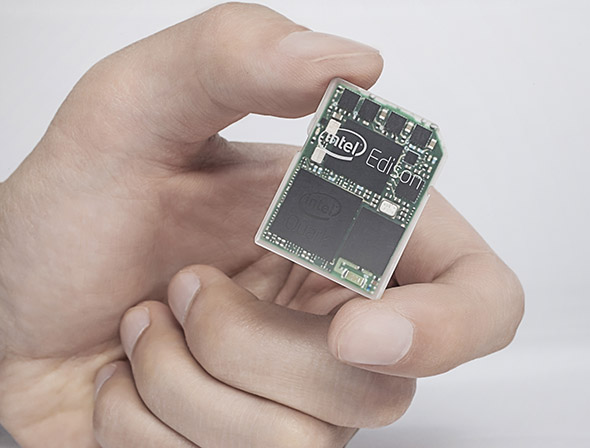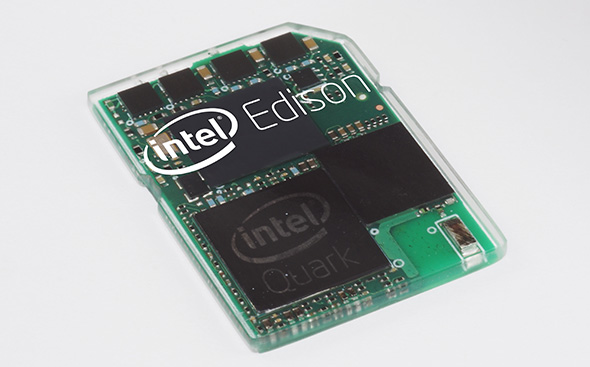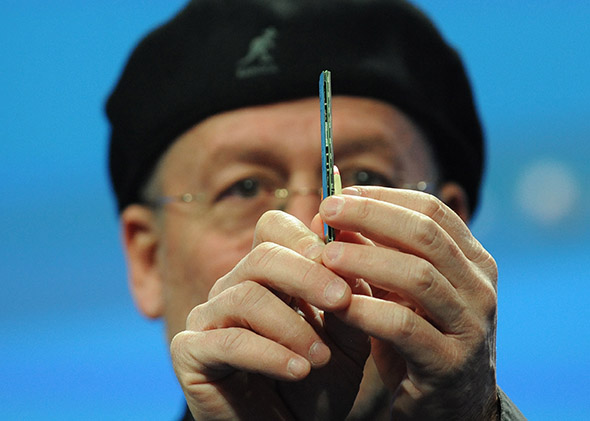Intel Offering Quark-Based Edison Development Board And RealSense 3D Camera
If Intel wanted to, it could maintain its status quo and churn out loads of processors for most of the desktops and laptops (and many mobile devices) in the world, raking in money hand over fist for years to come, but the company, under the leadership of new CEO Brian Krzanich, is demonstrating that it wants to maintain that innovative edge with two new unconventional technologies.
One is the tiny Edison development board, and the other is a futuristic way to interact with computers called RealSense.

Intel Edison development board
Simply put, the Intel Edison Development Board is an SD card-sized computer that features an extremely low-power 22nm dual-core 400MHz Intel Quark processor that allows users to develop using a host of devices. “It can be designed to work with most any device—not just computers, phones, or tablets, but chairs, coffeemakers, and even coffee cups,” reads an Intel post. “The possibilities are endless for entrepreneurs and inventors of all kinds.”

Edison has integrated WiFi and Bluetooth, and it can house multiple apps that can be downloaded and installed just like any smartphone app. Intel demoed Edison in action within a wireless baby monitor, a baby onesie that senses vitals and other body information, and a coffee warmer, but you can imagine myriad applications for such a tiny yet powerful device.
The development of Edison, as well as the Galileo Arduino-compatible board, shows that Intel is not only not intimidated by the burgeoning maker market, it’s embracing and empowering it.

Intel's Mooly Eden holding RealSense 3D camera
More impressive is Intel RealSense technology, which is an effort to bring “human-like senses to Intel-based devices in a new family of hardware and software products”. One of the first RealSense products is the Intel RealSense 3D camera, 1080p HD 2D camera module that integrates 3D depth, modelled after the human eye. The camera can detect finger movements and facial features, scans in 3D, and it’s designed to “understand” foregrounds and backgrounds for greater control over augmented reality.

Devices with the Intel RealSense 3D camera
Intel hopes that RealSense will revolutionize how people learn, game, video conference, and more. 3D printing companies will work with Intel on 3D scanning and printing enabled by RealSense, and the technology is slated to appear in a number of 2-in1s, tablets, ultrabooks, notebooks, and AIOs surprisingly soon--as early as the beginning of the second half of 2014. A wide array of manufacturers including Acer, ASUS, Dell, Fujitsu, HP, Lenovo, and NEC are on board already.
Intel also announced its next-gen Dragon Assistant from Nuance, a natural-language personal assistant in that RealSense vein that’s designed to be a conversationalist that allows follows orders such as “play music”, “get answers”, and more.
One is the tiny Edison development board, and the other is a futuristic way to interact with computers called RealSense.

Intel Edison development board
Simply put, the Intel Edison Development Board is an SD card-sized computer that features an extremely low-power 22nm dual-core 400MHz Intel Quark processor that allows users to develop using a host of devices. “It can be designed to work with most any device—not just computers, phones, or tablets, but chairs, coffeemakers, and even coffee cups,” reads an Intel post. “The possibilities are endless for entrepreneurs and inventors of all kinds.”

Edison has integrated WiFi and Bluetooth, and it can house multiple apps that can be downloaded and installed just like any smartphone app. Intel demoed Edison in action within a wireless baby monitor, a baby onesie that senses vitals and other body information, and a coffee warmer, but you can imagine myriad applications for such a tiny yet powerful device.
The development of Edison, as well as the Galileo Arduino-compatible board, shows that Intel is not only not intimidated by the burgeoning maker market, it’s embracing and empowering it.

Intel's Mooly Eden holding RealSense 3D camera
More impressive is Intel RealSense technology, which is an effort to bring “human-like senses to Intel-based devices in a new family of hardware and software products”. One of the first RealSense products is the Intel RealSense 3D camera, 1080p HD 2D camera module that integrates 3D depth, modelled after the human eye. The camera can detect finger movements and facial features, scans in 3D, and it’s designed to “understand” foregrounds and backgrounds for greater control over augmented reality.

Devices with the Intel RealSense 3D camera
Intel hopes that RealSense will revolutionize how people learn, game, video conference, and more. 3D printing companies will work with Intel on 3D scanning and printing enabled by RealSense, and the technology is slated to appear in a number of 2-in1s, tablets, ultrabooks, notebooks, and AIOs surprisingly soon--as early as the beginning of the second half of 2014. A wide array of manufacturers including Acer, ASUS, Dell, Fujitsu, HP, Lenovo, and NEC are on board already.
Intel also announced its next-gen Dragon Assistant from Nuance, a natural-language personal assistant in that RealSense vein that’s designed to be a conversationalist that allows follows orders such as “play music”, “get answers”, and more.
HotHardware CES 2014 News And Events
Brought To You By:
Brought To You By:


